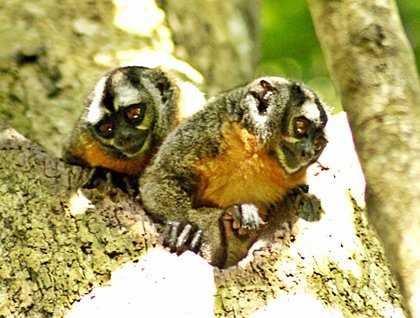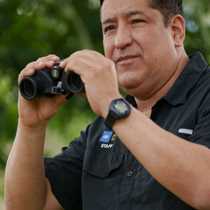Early in the morning at around 6:30 a.m. we boarded our skiffs and headed out to explore the Ucayali River looking for wildlife. We were successful for after looking around for approximately half an hour our patience paid off for we had wonderful sightings of a couple of chestnut-fronted macaws, green iguanas, hawks, swallows, and more. We observed one the iconic Amazon plants as well, the giant water lilies. Some of them had flowers.
After these sightings we turned off the Ucayali River and headed up a small tributary called Belluda Caño. This beautiful stream was as its best today for it gave us wonderful personal glimpses of the rain forest and its abundant wildlife. We spotted several bird species including jacamars, aracaris (small toucans), hawks, tanagers, and several parrot species including the fairly large mealy and festive parrots. We spotted a colorful caiman lizard as well.
The solitude and peacefulness of navigating along the creek, observing and listening to the forest sounds, makes you feel a real connection with nature and makes you think that the outside world seems in fact so far away. As our skiff slipped into narrower sections of the surrounding forests, we observed a dead hollow tree with several holes. In one of the holes that was directly overhead, several small heads with huge eyes were peeking down. We spotted a group of noisy night monkeys, the only genuinely nocturnal monkey species in the world. These not-well-known, taxonomically and ecologically speaking, primates have a beautiful owl-like rounded big head with huge eyes surrounded by white fur. The latter characteristics are good indicators of the monkey’s nocturnal habits. At night these creatures have a very diverse diet that includes fruits, buds, insects, and flower nectar.
More surprises were waiting for us. We spotted a couple of monk saki monkey troops. For long minutes we observed these monkeys collecting fruits, interacting, moving around, and a couple of them jumping around the thick foliage.
Just when we were extremely happy commenting how good the morning has been another surprise came out! We spotted a small troop of coati mundi (Nasua nasua). These secretive and silent raccoon-like mammals are very difficult to spot in the wild. In fact, this sighting is the first for me after some years coming to the Pacaya-Samiria Reserve in the Peruvian Upper Amazon. For Adonai Rodriguez, our Delfin II naturalist who was with us on the skiff, it is his first sighting after eight years!
We returned for breakfast which was followed by one of my favorite natural history talks, “Morphology, Ecology and Behavioral Notes of the Primates of the Pacaya-Samiria Reserve.” After the talk, Delfin II cabin boys Pedro Ruiz Jr. and Wilson Contreras taught us to fold towels origami-style. They are true masters in this amusing art for they decorate cabins on a daily basis with their artistic creations.
After lunch at three o’clock Delfin II naturalist Rudy Flores delighted us with his knowledge of some of the many Amazon fruits. We left later on at four o´clock heading up “El Dorado” River for a long excursion returning after dark to the ship. On our trip, we saw several three- toed sloths and some squirrel monkey troops.
The transition from day to night in the Neotropical rain forest is an amazing time to observe the wildlife transition along the river. As the light slowly faded, naturalists using strong spotlights tried hard to locate nocturnal wildlife. We found some small spectacled caimans in the floating vegetation.
After a delightful dinner, some talented musicians of the ship’s crew entertained us with lively music in the dining room putting the icing of the cake of a remarkable day of exploration in these remote realms.







